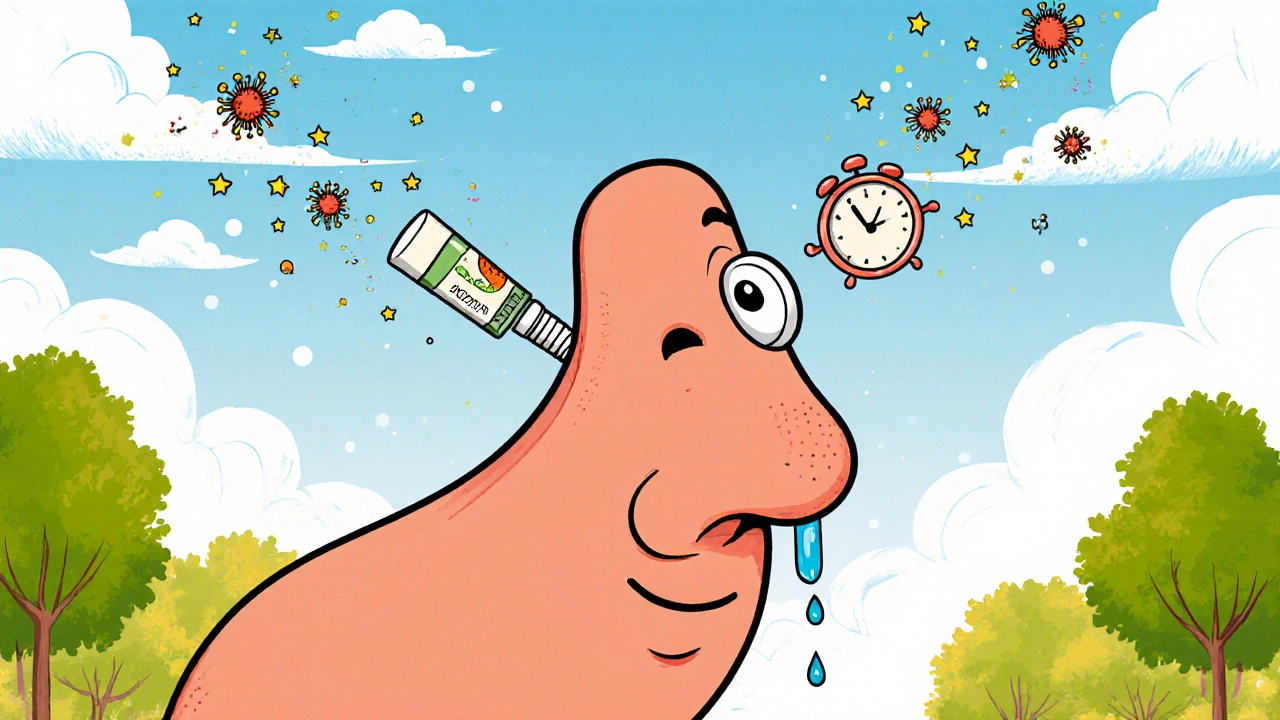
Allergy Treatment Selector
Find Your Best Allergy Treatment
Based on your symptoms and preferences, we'll recommend which allergy treatment is most suitable for you.
Your Recommended Treatment
Nasal antihistamine sprays offer fast, targeted relief for allergy symptoms-especially runny nose, sneezing, and itchy nasal passages. Unlike oral antihistamines that circulate through your whole body, these sprays deliver medication directly to your nose, where the reaction happens. That means quicker results and fewer drowsy side effects for many people. But they’re not perfect. Some users hate the bitter taste. Others get noseburn or occasional bleeding. Knowing how they work, what to expect, and how they stack up against other options can help you decide if they’re right for you.
How Nasal Antihistamine Sprays Work
Allergies happen when your immune system overreacts to harmless things like pollen or pet dander. Your body releases histamine, a chemical that triggers sneezing, itching, and a watery nose. Nasal antihistamine sprays block histamine receptors right in your nasal lining. That stops the signal before it causes symptoms.
The two main active ingredients are azelastine (found in Astepro and Astelin) and olopatadine (Patanase). Azelastine is also a mast cell stabilizer, meaning it helps prevent histamine from being released in the first place. This dual action makes it especially effective for sudden flare-ups.
Each spray delivers a precise dose-usually 140 mcg per spray for OTC versions. You typically use two sprays in each nostril once or twice a day. Effects start in 15 to 30 minutes, and relief lasts up to 12 hours. That’s faster than steroid sprays like Flonase, which can take 3 to 4 days to kick in.
Key Benefits of Nasal Antihistamine Sprays
- Fast relief: Works within minutes, ideal for sudden allergy attacks or before going outside on high-pollen days.
- Targeted action: Only affects your nose, so less drowsiness than oral antihistamines like Zyrtec or Claritin.
- Strong on runny nose: Clinical studies show 70-80% effectiveness in reducing watery discharge-better than most oral options for this specific symptom.
- OTC availability: Astepro (azelastine 0.1%) is now available without a prescription, making it more accessible than before.
- Good for combination use: Doctors often recommend pairing it with a steroid spray like Flonase for full symptom control.
People who struggle with drowsiness from oral meds or need quick relief during pollen season find these sprays especially helpful. One user on Reddit said, “Astepro changed my life for seasonal allergies-the runny nose stops within 20 minutes.”
Common Side Effects
While nasal sprays are localized, they still come with downsides. The most common complaints aren’t dangerous-but they’re annoying enough to make people quit.
- Bitter taste: Reported by 30-40% of users. It’s not harmful, but it lingers. Many people drink orange juice or water right after to mask it.
- Nasal burning or stinging: About 25% feel this on the first few uses. It usually fades after 3-5 days of consistent use.
- Nosebleeds: Occur in about 15% of users, especially if you spray too hard or aim at the center of your nose.
- Dry nose or sore throat: Less common, but still reported.
These side effects are more frequent than with steroid sprays. One study found 20-30% of antihistamine spray users reported taste or irritation issues, compared to 10-15% for steroid sprays.
How to Use Them Right
Using the spray correctly makes a big difference. Many side effects happen because people aim wrong.
- Prime the pump: Before first use, press it 5-6 times until a fine mist appears.
- Shake the bottle: Do this before every use.
- Aim away from the center: Tilt your head slightly forward. Point the nozzle toward your ear, not straight up or at the septum (the wall between your nostrils). This reduces irritation and bleeding risk.
- Breathe gently: Don’t snort hard. Just inhale softly as you spray.
- Don’t blow your nose right away: Wait at least 10 minutes so the medicine can absorb.
Some users find it helps to rinse their nose with saline spray 15 minutes before using the antihistamine. One 2022 survey showed this cut irritation complaints by 40%.
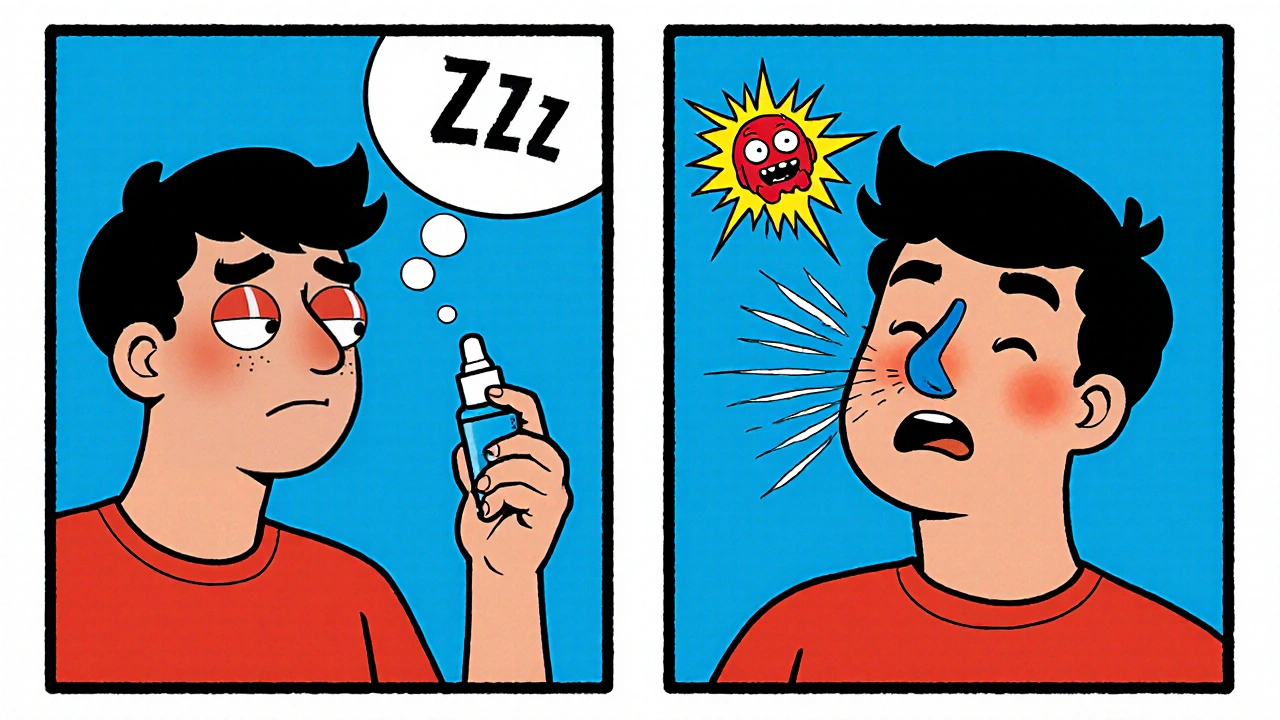
How They Compare to Other Allergy Treatments
Not all allergy sprays are the same. Here’s how nasal antihistamines stack up against the most common alternatives:
| Treatment Type | Examples | Speed of Relief | Best For | Main Side Effects | Cost (30-day supply, OTC) |
|---|---|---|---|---|---|
| Nasal Antihistamine Spray | Astepro, Astelin | 15-30 minutes | Runny nose, sneezing | Bitter taste, nasal burning | $25-$35 |
| Nasal Steroid Spray | Flonase, Nasacort | 3-4 days | Congestion, inflammation | Nosebleeds, dryness | $15-$20 |
| Oral Antihistamine | Zyrtec, Claritin | 1-2 hours | General symptoms, itchy eyes | Drowsiness, dry mouth | $10-$15 |
| Nasal Decongestant Spray | Afrin | 5-10 minutes | Severe congestion (short-term) | Rebound congestion (if used >3 days) | $10-$15 |
Nasal steroids are still the first-line treatment for moderate to severe allergies because they reduce long-term inflammation. But if your main problem is a constant runny nose, antihistamine sprays often work better and faster.
Decongestant sprays like Afrin give instant relief-but they’re risky. Using them longer than 3 days can cause rebound congestion, making your nose even more stuffed up. That’s why doctors warn against them for regular use.
Who Should Use Them? Who Should Avoid Them?
These sprays are ideal for:
- People with seasonal allergies (pollen, mold, ragweed)
- Those who get mostly runny nose and sneezing-not congestion
- Users who can’t tolerate drowsiness from oral meds
- People who want fast relief before going outdoors
They may not be the best choice if:
- Your main symptom is nasal congestion (steroid sprays work better)
- You hate the bitter taste and won’t stick with it
- You have frequent nosebleeds or a history of nasal surgery
- You’re pregnant or breastfeeding (talk to your doctor first)
For year-round (perennial) allergies, studies show antihistamine sprays are slightly less effective-about 55% symptom reduction versus 65% for seasonal allergies. That doesn’t mean they don’t work, just that they’re not the top pick for constant exposure.
Cost and Availability
OTC versions like Astepro cost $25-$35 per bottle (120 sprays). Prescription azelastine (Astelin) can cost $300 without insurance-making OTC the smart choice for most people.
Generic steroid sprays like fluticasone are cheaper ($15-$20) and often covered by insurance. But if you’re paying out of pocket and need fast relief, the antihistamine spray’s price is fair for what it delivers.
Newer combination sprays like Dymista (azelastine + fluticasone) are now available by prescription. They tackle both inflammation and histamine at once, helping 92% of users-better than either drug alone. But they’re more expensive and still need a doctor’s note.
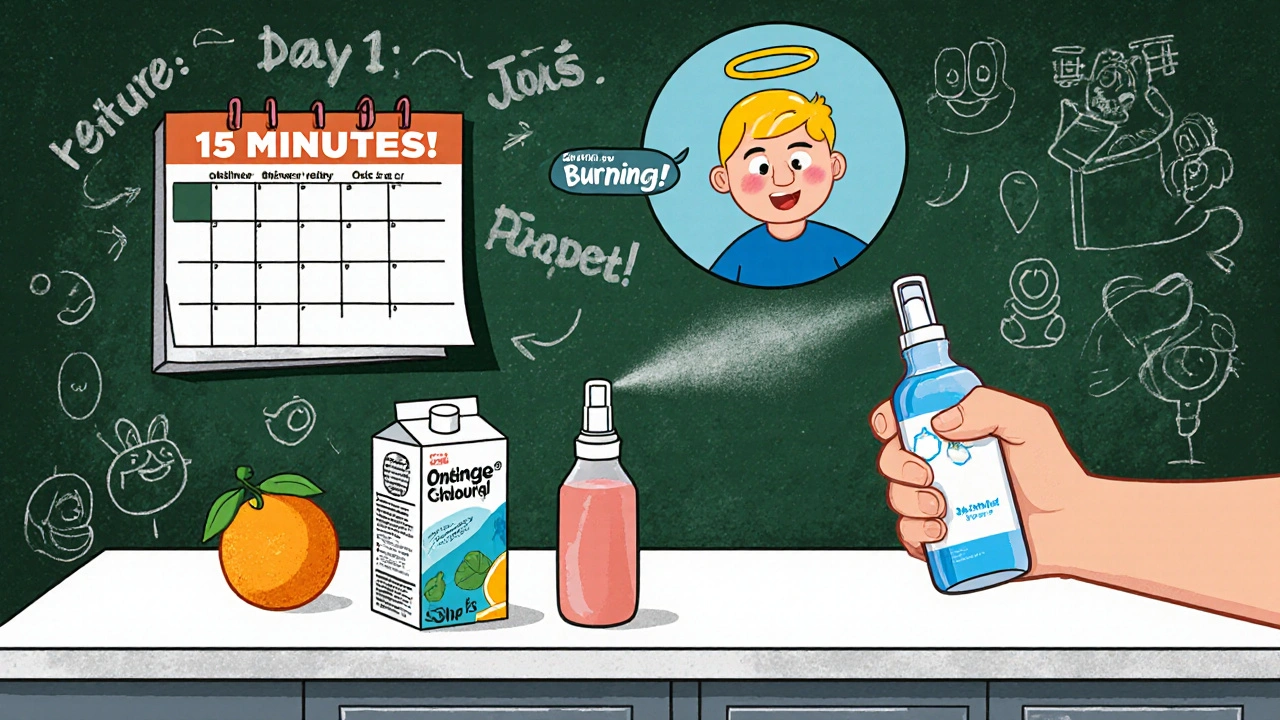
What’s New and Coming
In June 2023, a new azelastine formula got FDA approval with encapsulation tech that reduces bitter taste. In clinical trials, it cut taste-related dropouts from 28% to 12%.
A once-daily olopatadine spray is in late-stage trials. If approved, it could improve adherence-right now, only 65% of users stick with twice-daily dosing.
The American College of Allergy, Asthma, and Immunology updated its guidelines in September 2023 to recommend nasal antihistamines as first-line for patients with mostly runny nose symptoms. That’s a big shift, reflecting stronger evidence of their targeted power.
Real User Experiences
On Drugs.com, azelastine has a 6.2/10 average rating. Positive reviews (43%) praise the speed of relief. Negative ones (28%) almost always mention the taste or burning.
One Amazon reviewer wrote: “Works incredibly well for my pollen allergies, but I have to drink orange juice immediately after to mask the bitter taste.”
Another user on Walgreens said: “Caused such intense burning the first few uses I had to stop-Flonase works better for me despite taking longer to kick in.”
The pattern is clear: if you can tolerate the taste and initial sting, these sprays are powerful. If you can’t, you’ll quit-and miss out on real relief.
Final Thoughts
Nasal antihistamine sprays aren’t for everyone, but for the right person, they’re a game-changer. If your allergies hit hard with a constant runny nose and sneezing, and you want relief without feeling sleepy, they’re worth trying. Just learn how to use them right, give them a few days to settle in, and use a citrus drink to beat the taste.
They’re not a replacement for steroid sprays if you have chronic congestion or inflammation. But used together? That’s where the real power lies. Many doctors now recommend both-steroid in the morning, antihistamine at night-for full control.
With new formulations coming that reduce side effects, and more people recognizing their fast-action benefits, nasal antihistamine sprays are becoming a staple-not a backup-in allergy care.

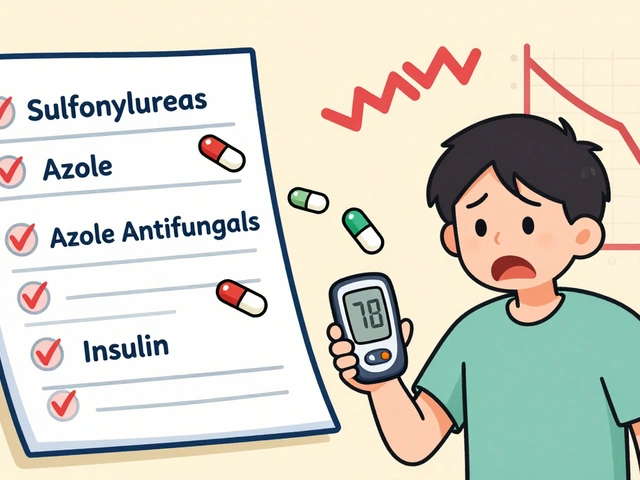
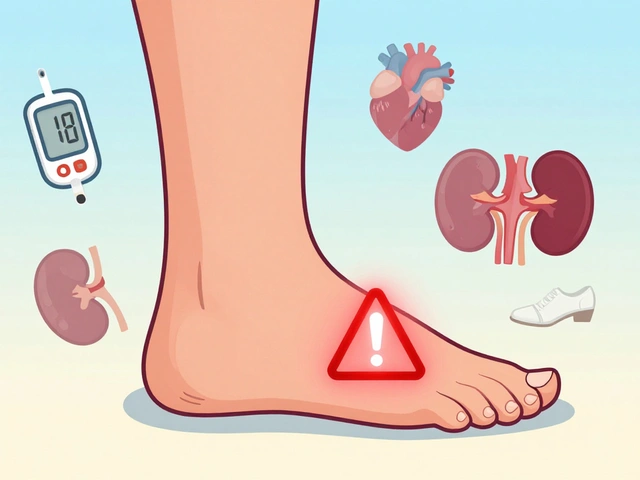


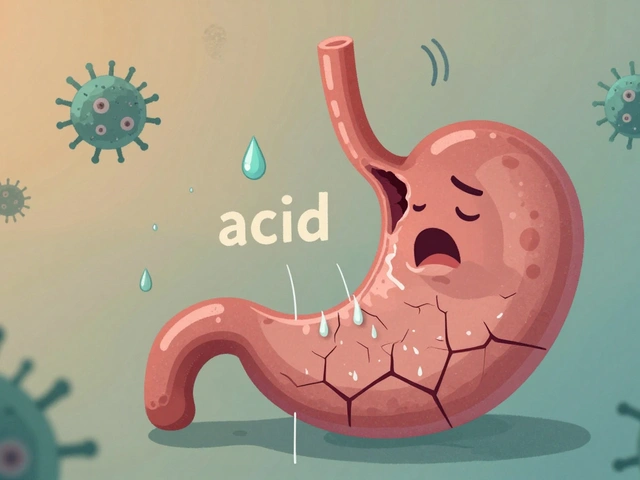
9 Comments
Oh wow, another article telling me to ‘just aim the spray toward my ear’ like I’m some kind of nasal archer. Newsflash: I’ve been using this stuff since 2018 and I still taste the bitter soul of a thousand bees every time. And no, orange juice doesn’t help-it just makes me feel like I’m chewing on a pharmacy.
Also, ‘OTC availability’? Please. Astepro’s price went up 300% last year. You call that accessible? I call it corporate greed with a nasal nozzle.
And don’t even get me started on ‘dual-action’-yeah, it blocks histamine AND prevents release… right after it ruins my sense of taste for the rest of the day. Thanks, science.
Meanwhile, my cat sneezes louder than I do. Maybe I should just let him be the allergen.
Also, who wrote this? A pharmaceutical rep with a thesaurus and zero lived experience?
Ugh, I hate how everyone acts like nasal sprays are some magical cure. I tried Astepro for two weeks. Burned like I’d snorted hot sauce. Bleeding on day 4. Then I switched to Flonase and my nose stopped acting like a leaky faucet AND I didn’t need to gargle with Tropicana to survive.
Also, ‘fast relief’? My runny nose didn’t stop-it just got quieter while I waited for the burn to subside. That’s not fast. That’s torture with a timer.
And don’t get me started on the ‘new encapsulation tech’-yeah, great, now we get to pay $40 for a spray that tastes like regret instead of despair.
Why do we keep pretending these things are better than just taking a pill and going to bed? I’m tired of being sold snake oil with a plastic pump.
What’s next? Americans can’t even sneeze without a $30 prescription? Back in my day, we just drank whiskey and held our noses. No sprays, no pills, no ‘dual-action’ nonsense.
And now they’re telling us to ‘aim toward the ear’? That’s not medicine, that’s origami with a spray bottle.
Meanwhile, China’s got a 98% success rate with acupuncture for allergies. But no, we gotta buy fancy American nasal sprays that make you taste your own soul.
Also, why is this even on Reddit? This isn’t news-it’s a commercial for Big Pharma with a PowerPoint slide deck.
Hey everyone-I’ve been using azelastine for 5 years now, and I want to share what actually helped me:
First, don’t spray right after blowing your nose. Wait 15 minutes. Your nasal passages need to be clear but moist. I use a saline rinse (neti pot) every night before bed, then spray in the morning. Game changer.
Second, the taste? I freeze the bottle for 10 minutes before use. Cold numbs the taste buds a little. Also, suck on a mint *after* spraying-not before. Mint resets your palate better than orange juice.
Third, if you’re getting nosebleeds, you’re aiming too high. Point it toward your pinky finger, not your brain. And breathe in gently. Like you’re smelling a flower, not a firehose.
Also, if you’re pregnant? Talk to your OB-GYN. I had a friend who used it safely in her third trimester-no issues. But don’t guess. Ask.
And yes, it’s weird at first. But if you stick with it for 7 days, your nose forgets it’s being sprayed. It just… works.
And if you’re still struggling? Try the combo spray. Dymista isn’t cheap, but if you’re on insurance, it’s worth it. I went from 3 missed workdays a month to zero.
You got this. It’s not magic. It’s just science with a little patience.
PS: Typo? I meant ‘pinkie’ not ‘pinky.’ Sorry, autocorrect hates me too 😅
So we’ve reduced human suffering to a 15-minute spray and a citrus chaser… how poetic.
Is this what enlightenment looks like? A nose that doesn’t drip… but your tongue is haunted by the ghost of a chemist’s lunch break?
They say ‘targeted relief’-but isn’t that just capitalism with a nasal cannula? We don’t want to fix the system-we just want to spray it into silence.
And yet… I still use it.
Because sometimes, the only rebellion left is to survive the pollen season without crying in the grocery aisle.
🫁🧄🍊
Hey, just wanted to say thank you for this incredibly thorough breakdown. I’ve been struggling with seasonal allergies for over a decade, and this is the first time I’ve actually understood how these sprays work-not just what they do, but why they do it.
I tried Astepro last spring and gave up after two days because of the taste and burning. But now I know: it’s not me, it’s the technique. I’m going to try the saline rinse trick before spraying, and I’ll aim toward my ear like Paula said.
Also, the comparison table? Perfect. I printed it out and stuck it on my bathroom mirror. I’m giving it another shot this season.
It’s easy to feel defeated by allergies. But when you have clear, compassionate info like this? It gives you hope.
Thank you for writing this. Seriously.
P.S. I’m not great at spelling, but I hope this came across right 😊
As a respiratory therapist in Mumbai, I’ve seen this play out globally. Nasal antihistamines? Brilliant for urban allergen profiles-pollen, PM2.5, diesel particulates. But in India, most patients can’t afford even OTC versions. We use saline + steam + neem oil as first-line. Cheap. Effective. Cultural.
That said, if you’re in the US and can access it? Yes, this is a tier-one tool for rhinitis. But don’t treat it like a panacea. It’s a tool. Like a hammer. Use it right.
Also, the ‘bitter taste’? That’s the drug’s bioavailability indicator. If it doesn’t taste bad, it’s not hitting the receptors. So embrace the flavor. It’s your immune system saying ‘I see you.’
And yes, the new encapsulation tech? That’s a win. Reducing dropout rates by 16%? That’s not just science-that’s public health impact.
Stop treating allergies like a personal failure. They’re environmental. Your nose is just the messenger.
One of the most accurate and well-researched allergy guides I’ve read in years. The breakdown of symptoms versus treatments is spot-on. I’ve recommended this to three friends already.
Also, the point about aiming the spray toward the ear? Crucial. I had a patient who was bleeding daily because she was aiming straight up. Once we corrected her technique, her nosebleeds stopped. No change in dosage-just angle.
And yes, the bitter taste is real. But it’s temporary. I tell my patients: think of it like the taste of medicine as a sign it’s working. Like a bitter pill, but in your nose.
Thank you for including the cost comparisons and the new FDA-approved formulation. That’s the kind of detail that saves people time, money, and frustration.
Well done.
Just wanted to say I tried this last week and it actually worked. No joke. First day: tasted like regret. Second day: still tasted like regret. Third day: didn’t even notice the taste. Just… stopped sneezing.
Also, I did the saline rinse thing before spraying. Didn’t think it’d do anything. Turns out it did.
Now I’m not running around like a human tissue dispenser. Small wins, man.
Thanks for the tips. I’m not a medical person but this made sense.